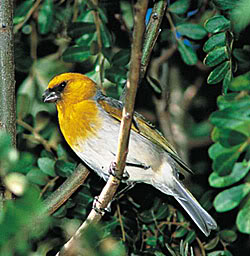|
|
The environmental legal organization, Earthjustice, has filed legal papers against the Hawaii State Department of Land and Natural Resources for failing to keep feral sheep and goats out of the critically-endangered palila bird’s last habitat. According to Earthjustice, the court has already issued three orders beginning in 1979 that found the state of Hawaii in violation of the Endangered Species Act by not protecting the palila bird from the destructive feeding practices of sheep and goats.
The palila birds and the feral sheep and goats are currently in competition for native mämane trees. The palila birds nest in these trees and feed on their seeds and native caterpillars found only in their seedpods. The sheep also feed on mämane trees, consuming some of the food sources that the critically-endangered palila bird depend on. But even more worrisome to conservationists, the sheep have a tendency to kill young mämane trees, destroying in the long-term the final habitat for palila birds.
 Critically-endangered palila bird on a mämane tree. Photo by: USGS. |
“The state is not taking effective action to keep the sheep out of the palila’s critical habitat, and the palila population is suffering for it,” said John Harrison, president of the Hawaii Audubon Society. “Palila are on a crash-course toward extinction in large part because browsing animals are allowed to continue to destroy their only habitat.”
In five years, the palila population has dropped more than 60 percent, from 6,600 individuals in 2003 to 2,600 in 2008.
Earthjustice is asking the Hawaii State Department of Land and Natural Resources to construct a fence by 2011 that would keep sheep and goats out, in addition to increase the effectiveness of sheep hunting that already occurs in the habitat. Earthjustice filed the papers on behalf of the Hawaii Chapter of the Sierra Club, the Hawaii Audubon Society, and the National Audubon Society.
According to a recent report on bird populations in America, Hawaii was identified as the state experiencing the most dire bird crisis: 31 bird species are currently endangered in Hawaii. Out of 13 birds that are considered possibly extinct in the US, nine of them are from Hawaii.
Related articles
One third of US birds endangered
(03/19/2009)
Ken Salazar, the nation’s new Secretary of the Interior, today released the first comprehensive report on bird populations in the United States. The findings are not encouraging: nearly one third of United States’ 800 bird species are endangered with even once common species showing precipitous declines. Habitat loss and invasive species are blamed as the largest contributors to bird declines.
Seeking out the world’s rarest and most endangered birds
(02/02/2009)
For an evolutionary biologist there is no conservation group whose work is more exciting than EDGE, a program developed by the Zoological Society of London (ZSL). Unique in the conservation world, EDGE chooses the species to focus on based on a combination of their threat of extinction and evolutionary distinctness. Katrina Fellerman, an evolutionary biologist herself and the EDGE birds’ coordinator, describes the organization as one that focuses on species, which “to put it bluntly, if lost, there would be nothing like them left in the world today”. Explaining further Fellerman says “We use evolutionary distinctiveness (ED) as a species-specific measure of the relative evolutionary value of species – it is a way of apportioning conservation value according to a species’ phylogenetic position. Species with few or no close relatives on the ‘tree of life’ have the highest ED scores.”
Global warming may doom emperor penguins to extinction
(01/27/2009)
Disappearing sea ice around Antarctica may put emperor penguins at risk of extinction within the next century, warn scientists writing in this week’s Proceedings of the National Academy of Sciences.
U.S. Fish and Wildlife Service program restores bird habitat on farms and ranches
(10/28/2008)
Matt Filsinger is driving his white pickup headed northeast from Sterling to look at two of his projects. This self-described introvert speaks enthusiastically about his job. “Ducks, ducks, ducks – that’s what I love!” says Filsinger, grinning broadly. Filsinger is a wildlife biologist with the Partners for Fish and Wildlife Program of the U.S. Fish and Wildlife Service. He works with private landowners to set aside land and create attractive habitat for imperiled species. Specifically, he designs wetlands to attract waterfowl. Partners for Fish and Wildlife is a successful program that has been around since 1987. Landowners, including farmers and ranchers, form partnerships with the program because they reap a variety of benefits from it. Nonprofit organizations such as Ducks Unlimited, Audubon and the Rocky Mountain Bird Observatory are also partners. Collaboration between the federal government and private landowners is essential to preserving habitat and species, as 73 percent of the country’s land is privately owned, and most wildlife lives on that land.